The Beat’s Gregory Paul Silber has been accused of having a bit of an… obsessive personality. Each week in Silber Linings, he takes a humorous look at the weirdest, funniest, and most obscure bits of comics and pop culture that he can’t get out of his head.
A new trailer for The Batman, the upcoming 2022 film starring Robert Pattinson debuting in the title role, dropped this week. Normally, I’m not into the “trailer speculation” side of geekdom. That’s not to say I avoid trailers entirely. I just think the practice of poring over every detail to analyze on your blog or YouTube channel or whatever is a little silly. When the movie comes out I’ll watch it, and we can spend our energy ranting to each other about it then.
But as someone who loves Batman more than the vast majority of things in the world (there are maybe five people and concepts I love more), I have a lot of thoughts about one shot from the latest Batman trailer in particular: Batman smacking around a bunch of bad guys with a big gun, which he presumably (hopefully) took off the hands of another crook.
I never, ever want to see Batman shoot a gun but that doesn't mean he can't beat someone's ass with their own gun
— Gregory Paul Silber (@GregSilber) December 28, 2021
It’s not just that the shot suggests the new movie will have some badass action (incidentally, I’m of the perhaps-controversial opinion that Batman-in-film has largely been lacking in the action department, but that’s an essay for another time). It’s that the shot suggests this movie may examine a crucial aspect of Batman’s characterization that’s been explored at lengths in comics, but mostly ignored in film: his hatred of guns.
Before we unpack that, we need to address a broader rule that creators have traditionally followed for Batman since his inception: his code against killing. While it’s arguably been codified for Batman more than any other superhero with the possible exception of Superman, I think it’s safe to say that most superheroes don’t kill… at least not in comics, but we’ll get to that later. Characters like The Flash, Spider-Man, and countless others may not talk about it as much as Batman, but it’s something of an unwritten rule. There are exceptions, of course, but instances of Marvel or DC superheroes taking another person’s life are generally treated as unusual circumstances, both in-universe and when we’re talking about it in the real world.
There’s a more in-depth conversation to be had about why killing is unheroic, but as far as I’m concerned, it has more to do with the fact that superheroes are historically a children’s genre. Killing is bad at any age, sure, but you certainly don’t want to impart “murder is a reasonable means of settling disputes” as a lesson for impressionable youths. That hasn’t stopped plenty of classic stories geared towards children from ending with the violent death of a villain, but it’ll always be a bit unseemly.
As for Batman specifically, many creators have had Batman textually explain why he refuses to take a life. It usually comes down to some variation of “if I killed my enemies I’d be no better than they are.” This is something that a lot of fans gripe about. For one thing, Batman already serves as something of a self-appointed judge and jury, so why, they say, would he stop at being an executioner? And to that I say… I dunno man, beating someone up real bad still isn’t nearly as violent as ending their life?
The argument can also get complicated when you start asking questions like “should Batman kill The Joker?” Because let’s be real: if we were using real-world logic, the death of an evil clown who’s murdered literally countless people would absolutely be a net-positive for humanity. I’m firmly opposed to capital punishment in real life, but we’re talking about a character who’s killed more people than every real-life serial killer combined, and also escapes from prison constantly. There’s little moral or logical justification for keeping someone like that alive.
But here’s what so many people who argue about Batman struggle with: if you’re applying real-world logic to a character like Batman, you’re missing the point. It’s the same with that smug “Batman should simply use his money to end crime” nonsense that pops up on Twitter every two weeks. The people who make arguments like that… first of all, let’s be real, they’re usually informed by movies and television, not the comics source material. But more importantly, they’re not engaging with the text in a way that demonstrates understanding of the rules and conventions of the fictional universe in which Batman occupies. Saying that Batman should kill the Joker doesn’t make a whole lot more sense than saying that Spongebob should kill Plankton.
(This is a good time to mention that when I briefly, somewhat-accidentally became president of the Rowan University Philosophy Club, the subject of the first meeting I led was “should Batman kill the Joker.”)
This is also the biggest reason why Zack Snyder‘s 2016 blockbuster Batman v Superman: Dawn of Justice will probably (hopefully) forever be my least favorite movie of all time… and I’m saying that as someone who just saw The Human Centipede 2: Full Sequence earlier this week (as part of my research for an upcoming essay on metafiction in horror; I didn’t just decide to watch The Human Centipede 2 because I thought it would be a fun time).
BvS: DoJ is a morally repugnant film in general, a dunderheaded bastardization of the classic ideals of the superhero genre that thematically suggests “might makes right” is a reasonable worldview with none of the nuance it thinks it has. I don’t need to reiterate everything wrong with that movie when other critics have covered it ad nauseum, but what really made me want to throw my popcorn across the room were the scenes in which Batman kills people with handguns. It’s not the first movie in which Batman has killed on screen, which started in 1989 with Batman cartoonishly killing bad guys and even driving a Batmobile with guns. To be clear, I don’t like that either. But there’s something particularly noxious about Batman killing enemies with the same kind of weapon that killed his parents.
Scenes like that feel like a betrayal of everything that I love about Batman, and I don’t just mean that from an ethical standpoint. Batman’s aversion to guns also has an aesthetic appeal. It’s not the same as with a character like Superman. Superman doesn’t use a gun for a host of reasons, not the least of which being that his powers render firearms wildly unnecessary. But it also wouldn’t work for him aesthetically. Superman with a gun would just look silly. But from his pulp roots, to his lack of powers, to his dark costume, to the fact that he’s the kind of character who fights multiple bad guys at a time on a nightly basis, action genre conventions dictate that it would make sense for Batman to carry a gun. And yet he doesn’t, and I think that adds an exciting wrinkle to the fights he gets in.
Now, whenever the argument about whether Batman should use guns comes up, a lot of misinformed folks are quick to point out the handful of images from Batman’s earliest Golden Age comics appearances in which he carried a firearm.
I understand why this may be a difficult thing for casual fans to grasp, but it took several months following Batman’s debut in 1939’s Detective Comics for him to develop the personality that we would later come to associate with classic Batman. If you read those early comics you’ll see what I mean. First of all, even within those stories, Batman’s use of guns is quite limited. But more broadly, it had more to do with the fact that, at that time, he was a pulp character, and a not-too-subtle ripoff of The Shadow, specifically. It probably wasn’t until after Robin’s debut, when the Dark Knight got his own title in 1940’s Batman #1, that Batman was solidified in the still-nascent superhero genre… which might be to say that that’s when he really became a children’s character.
Yes, there have been a handful comics in which Batman has used guns, and even comics in which Batman killed, but I can’t overstate how much that’s the exception, not the rule. And when it comes to rules, it’s also hard to overstate the death of Batman’s parents as a child as a defining moment in his characterization. And if we’re going to talk about that, we have to talk about the role guns played in Bruce Wayne’s greatest trauma.
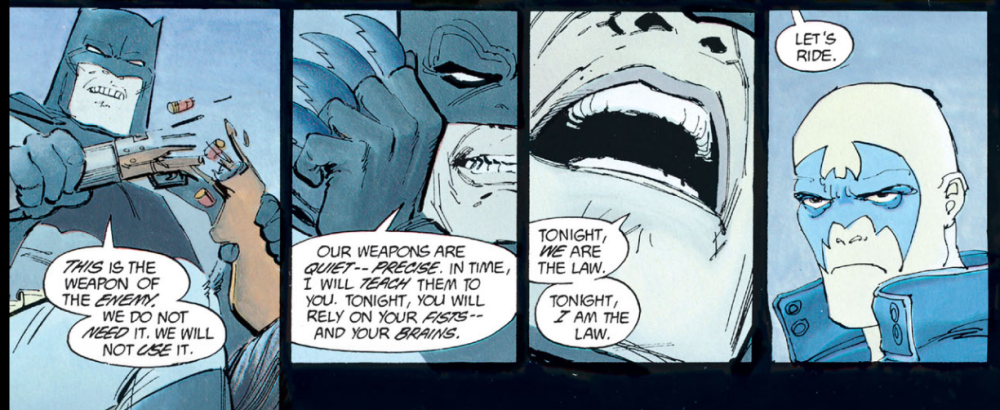
Guns, and specifically handguns, are a symbol of the antithesis for Batman’s mission. I’ve written about this before, but Bruce Wayne dedicated his life to his quixotic war on crime because he never wants another child to suffer a similar trauma to the one he suffered as a little boy when he witnessed Joe Chill gun down Thomas and Martha Wayne. For Bruce to use that same weapon – one that can instantly take the life of somebody’s child or parent in the blink of an eye – would be to betray his highest ideals.
I’m not as huge a fan of the Batman Beyond cartoon as a lot of Bat-fans my age, but I do think they did an excellent job illustrating that point in the very first episode. In a moment of desperation, an aging Batman reaches for a gun and comes close to shooting it at the bad guys who nearly overpower him. He doesn’t pull the trigger, ultimately, but the fact that he was so tempted to do so convinces Bruce that it’s time for him to retire and hand the mantle to someone younger and more physically fit.
Look, I have a strong distaste for guns both politically and personally in real life, but I’m not going to sit here and tell you guns can’t be fun in action/adventure fiction. I’m a passionate defender of fictional violence, and have a great deal of affection for stuff like The Matrix, 007 movies, and the comics of Kyle Starks. But the fact that Batman fights – and defeats! – hordes of gun-toting bad guys on a regular basis using an array of martial arts techniques and high-tech gadgets, but never guns, only makes him more badass. Fight scenes are always more exciting when the hero is seemingly disadvantaged… even if we all know Batman always wins.
That’s something writer Garth Ennis had a lot of fun with in the recent Batman: Reptilian miniseries with art by Liam Sharp. From the first issue, we see how Batman knows that Gotham’s criminal underground knows that he doesn’t kill. One might think such knowledge would make the bad guys less afraid, but Batman uses this to his advantage, tormenting the “superstitious and cowardly lot” by repeatedly telling them that he won’t kill them… with the terrifying implication that what he can do instead is a fate worse than death.
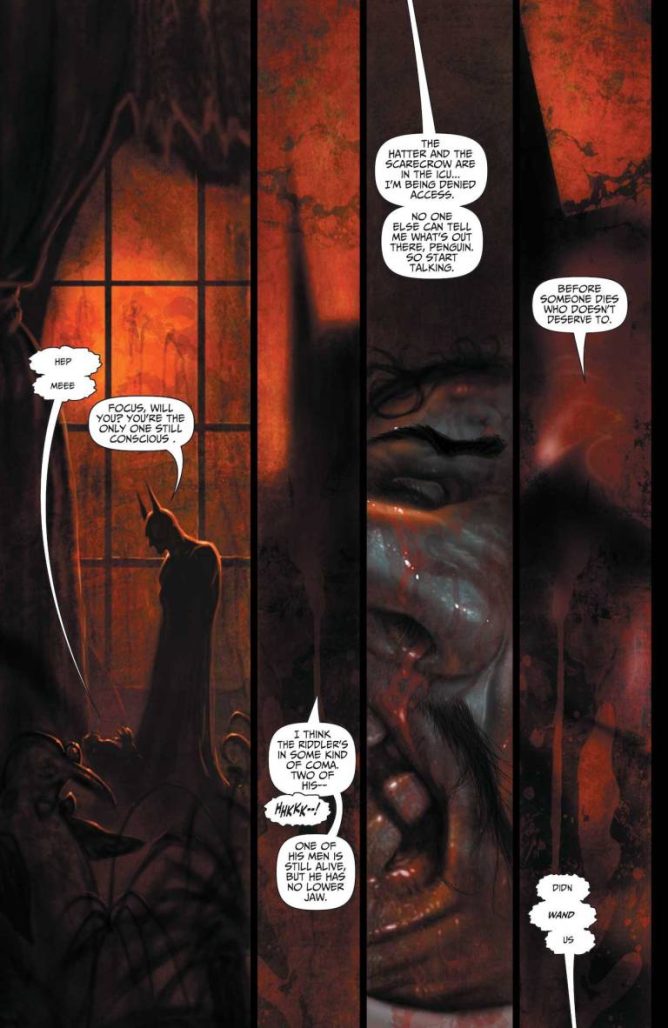
I love it when creators lean into Batman’s passion for his “code,” often to comedic effect. One of the most memorable parts of 1980’s The Untold Legend of the Batman, a retelling of his origin story written by Len Wein with art by John Byrne and Jim Aparo, plus colors by Tatjana Wood, is seeing Batman lose his shit the moment a crook pulls a gun on him. It makes me laugh out loud and pump my fists in the air at the same time.
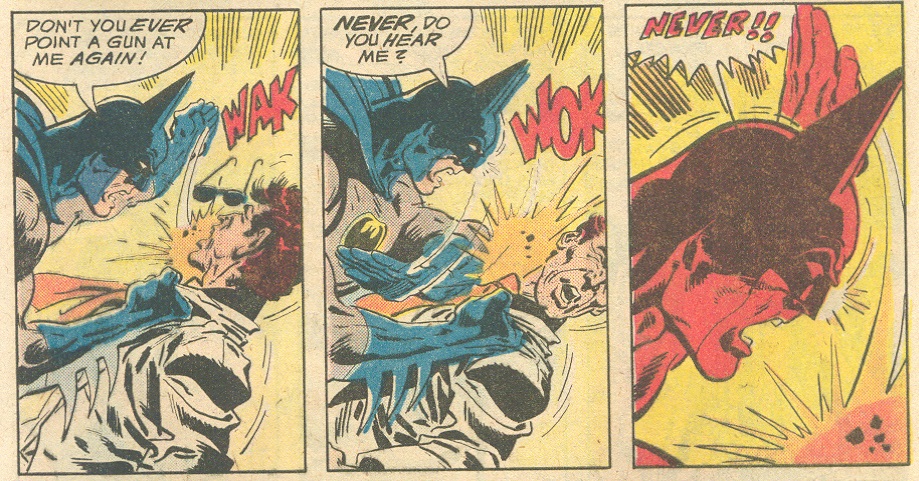
That’s the thing that I wish more of the “Batman should use GUNS and KILL PEOPLE because superheroes should be DARK and SERIOUS, GRRR” crowd understood about why Batman and guns are a bad combo. It’s not that I’m a moralist stick-in-the-mud (okay, maybe a little). It’s that Batman is way cooler when he doesn’t have to rely on the pathetic tools of mortal men, despite being a mortal man himself.
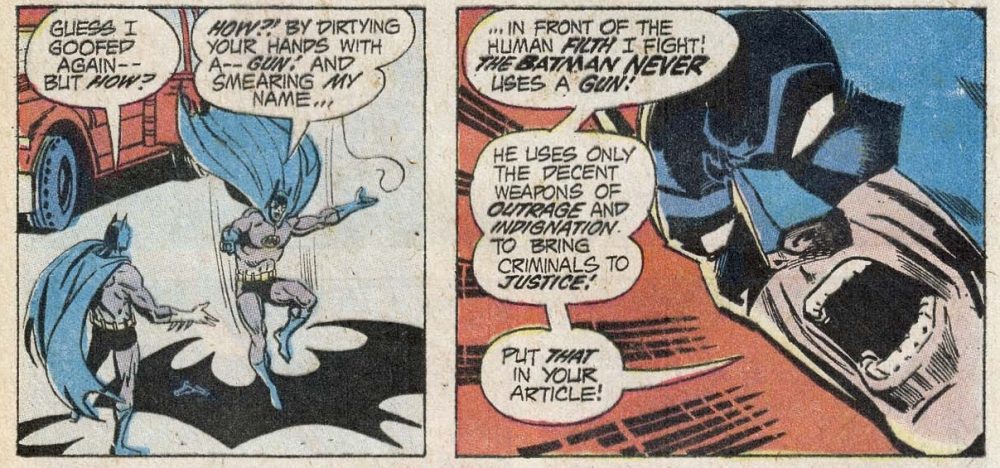


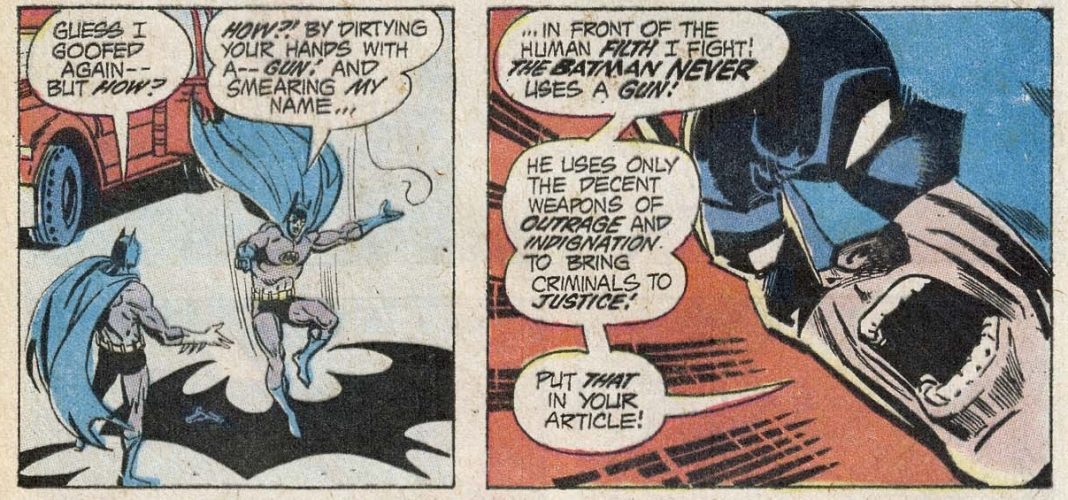
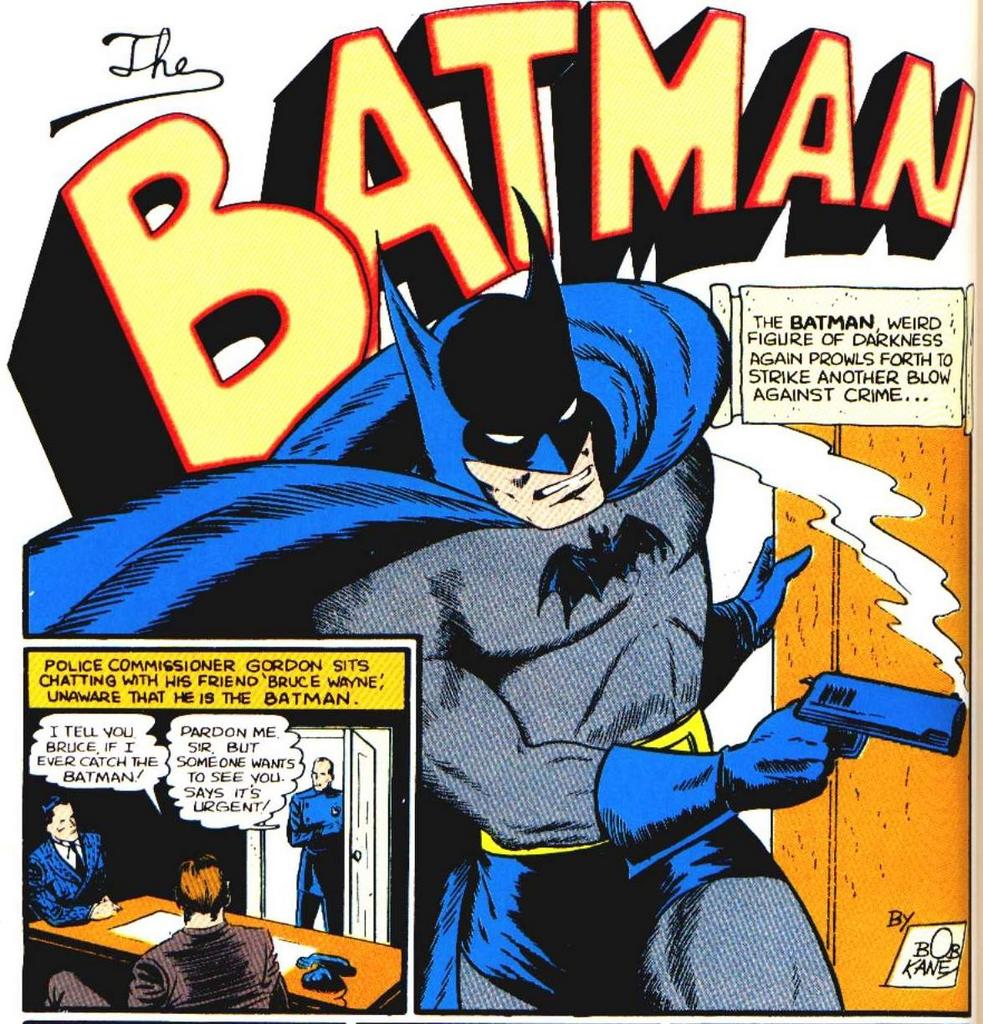

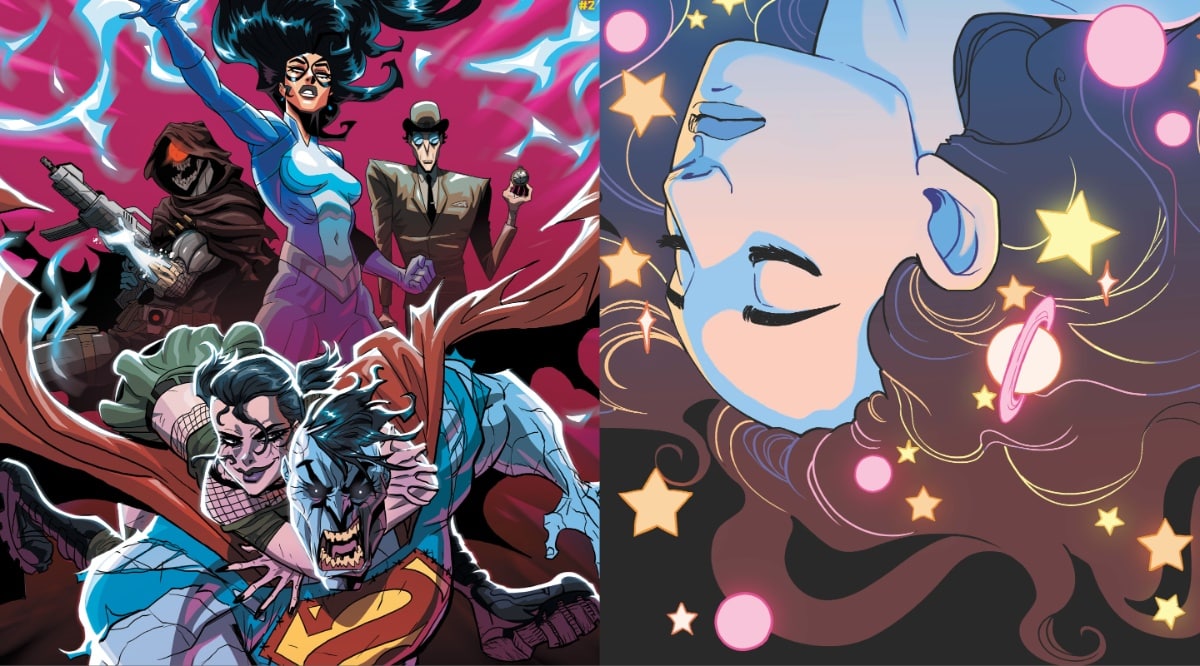




(This is a good time to mention that when I briefly, somewhat-accidentally became president of the Rowan University Philosophy Club, the subject of the first meeting I led was “should Batman kill the Joker.”)
I was there & argued from a position of legitimacy a la
“…not wearing hockey pads”
Good times.
Comments are closed.